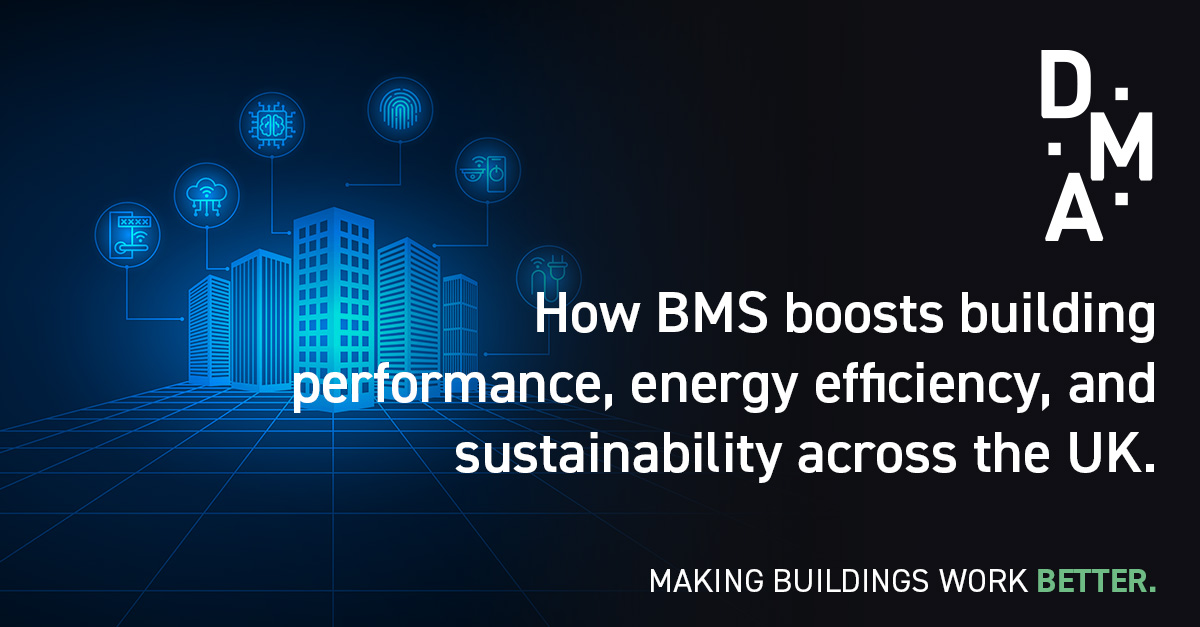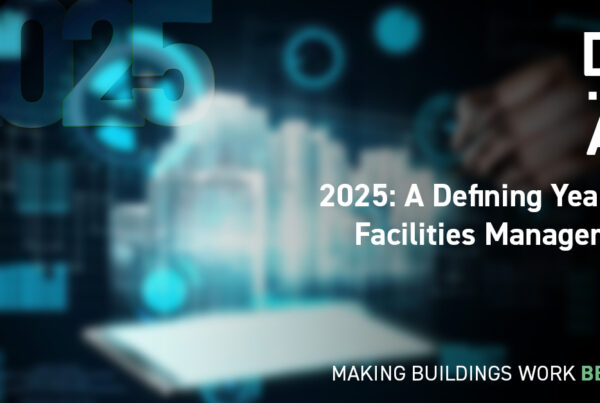
Discover how integrated BMS solutions are revolutionising building performance, energy efficiency, and regulatory compliance across the UK.
Today’s push for smarter, greener buildings is making digital systems like Building Management Systems (BMS) critical infrastructure across the UK’s commercial, healthcare, and educational sectors. From optimising energy use to automating climate control and improving safety, BMS solutions are helping buildings become smarter, greener, and more cost-efficient.
But what exactly is a BMS? How does it work, and why should facility managers, developers, and estate leaders be paying attention?
What is a Building Management System (BMS)?
A Building Management System, or BMS, is a computer-based system installed in buildings to control and monitor mechanical and electrical services such as heating, ventilation, air conditioning (HVAC) and lighting .
These systems play a pivotal role in improving occupant comfort, reducing energy consumption, and enhancing operational control — all through an integrated interface.
Often used interchangeably with Building Automation Systems (BAS), the two are closely related. While BAS is more focused on automation tasks, a BMS provides broader, centralised management and analytics capabilities.
How Does a BMS Work?
At its core, a BMS relies on a layered architecture made up of:
- Sensors that collect data on temperature, humidity, occupancy, CO₂ levels, lighting, and more.
- Controllers that process this information and determine responses based on pre-set logic.
- User Interfaces (UI) that allow building operators to monitor systems, make adjustments, and analyse data.
- Communication Protocols such as BACnet, Modbus, or KNX to connect different components.
Together, these create a networked ecosystem for controlling multiple building services from a single platform.
Key Building Systems Controlled by BMS
A modern integrated BMS platform typically manages:
- HVAC systems: To optimise indoor climate and energy use.
- Lighting systems: Automatically adjusting lights based on occupancy and daylight.
- Energy metering and analytics: Providing visibility into energy consumption and costs.
What are the Benefits of Implementing a BMS?
BMS technology offers a wide array of benefits to building owners, operators, and occupants alike, especially when paired with DMA’s Energy & Sustainability Services to maximise long-term savings and carbon reduction:
- Energy Efficiency and Cost Savings: Studies show that BMS solutions can deliver up to 30% in energy savings, particularly in HVAC and lighting systems.
- Operational Efficiency: With remote access, real-time alerts, and predictive maintenance tools, facility managers can identify issues early, reducing downtime and costly repairs.
- Enhanced Comfort and Safety: By monitoring air quality, lighting levels, and temperature, BMS helps maintain optimal conditions for health and wellbeing.
- Regulatory Compliance: BMS helps meet energy efficiency regulations such as the Energy Performance of Buildings Directive (EPBD) and supports net zero building targets.
”A well-configured BMS can be one of the most powerful tools in a building’s operational toolkit. It helps drive energy efficiency, reduce carbon emissions, and provide greater visibility over how systems are performing day-to-day. But all too often, I come across buildings where the BMS is already installed yet barely being used to its potential. In many cases, building operators either don’t know how to use the system, or the initial setup wasn’t aligned with the building’s actual needs. The truth is, there’s a lot more a BMS can do, and most of it doesn’t require a major investment. Simple adjustments and better user training can unlock significant gains. Every BMS has the capability to monitor energy consumption, track half-hour data, and pinpoint areas of unnecessary usage. With smart metering alone, organisations could cut on-site carbon emissions by between 5–12%.
Kevin McguaneEnergy Services Director
Addressing Common Challenges
Retrofitting in Older Buildings
Modernising legacy buildings is complex due to structural limitations and outdated electrical layouts. However, modular BMS solutions and wireless technologies are making retrofits more feasible.
Cybersecurity in BMS
With increasing connectivity, cybersecurity is now a major concern. Securing devices, encrypting data, and using multi-layered access controls are essential safeguards.
Skills Gap
The UK faces a shortage of skilled engineers trained in BMS deployment and maintenance. Upskilling and apprenticeships are crucial for sustaining the sector’s growth.
BMS Applications Across Different Sectors
BMS for Hospitals UK
Hospitals require 24/7 system reliability. BMS enables precise environmental control in wards and theatres while integrating fire and security systems to protect patients and staff.
BMS for Schools and Universities
Educational institutions benefit from better air quality, temperature control, and cost management — particularly important in budget-constrained environments.
BMS for Commercial Buildings
From office towers to shopping centres, commercial properties use IoT-enabled BMS to automate building services and provide energy usage insights for ESG reporting.
Industrial BMS Systems
Industrial facilities demand robust BMS platforms for monitoring production environments, safety protocols, and energy-intensive equipment.
Trends Driving BMS Adoption in the UK
The UK is seeing a significant shift in how buildings are managed and optimised. Several converging trends are accelerating BMS adoption:
1. Regulatory Pressure to Improve Energy Performance
The UK government’s continued focus on decarbonisation and climate targets is a major driver. Policies and local energy efficiency standards are pushing organisations to take greater control of their energy use.
BMS platforms play a vital role in helping buildings achieve and maintain compliance, particularly when paired with automated metering and real-time reporting capabilities.
BMS enables visibility over energy consumption and supports data-driven decisions to meet statutory obligations.
2. Rising Demand for Smart, Connected Buildings
There is a strong appetite for smart buildings that use IoT-enabled devices, sensors, and cloud-based platforms to centralise control of systems like lighting, HVAC and more.
These integrated BMS platforms enable remote monitoring, predictive maintenance, and analytics — all of which support better building performance and user experience. This trend is especially strong in new commercial developments and high-performance retrofit projects.
From office towers to hospitals, smart buildings are becoming the new standard for operational excellence.
3. The Drive for Cost Efficiency in Operations
As energy costs rise, and operational budgets tighten, particularly in public sector estates, the cost-saving potential of BMS is more important than ever.
By optimising energy use, automating building systems, and identifying inefficiencies, a well-configured BMS can generate savings of up to 30% on energy bills — especially in HVAC and lighting control. For many organisations, the return on investment is clear.
Smart metering alone can reduce carbon emissions on-site by 5–12%, according to the Carbon Trust.
4. Retrofit and Refurbishment Opportunities
There is growing demand to modernise the UK’s ageing building stock. Retrofitting older buildings with BMS systems is increasingly seen as a strategic investment, especially when combined with energy performance upgrades and sustainability goals.
While retrofitting can be complex — particularly in heritage or poorly-documented buildings — advances in wireless and modular BMS solutions are making it more accessible.
Retrofitting BMS into existing buildings supports carbon reduction goals without the need for full redevelopment.
5. Growing Focus on Cybersecurity and System Integration
With the increasing digitisation of building infrastructure, cybersecurity is emerging as a key concern for BMS adopters. Connected systems require robust security protocols to protect against data breaches and ensure safe operation.
At the same time, the ability to integrate BMS with other IT and operational systems — from CAFM software to fire and security platforms — is becoming a standard expectation for high-performing buildings.
Integrated, secure BMS platforms offer greater resilience, functionality, and long-term scalability.
A Global Perspective
These UK-specific trends are mirrored globally. The global BMS market, valued at $19.8 billion in 2024, is projected to grow at a compound annual growth rate (CAGR) of 15.3% through to 2034. (Source – Global Market Insights)
As both public and private sectors embrace digital and sustainable transformation, BMS adoption is set to continue its rapid upward trajectory.
Key Considerations for Selecting and Implementing a BMS
1. Choosing the Right BMS
Consider the building’s size, use, and existing infrastructure. Will it be a retrofit or new build? Are you seeking on-premise or cloud-native BMS platforms?
2. Cost of BMS Installation in the UK
BMS pricing varies significantly. Key cost factors include:
- Size and complexity of the building.
- Number of integrated systems.
- Customisation and software licensing.
- Cloud vs on-site server hosting.
Budget ranges can start from £20,000 for small buildings and go into six figures for large, multi-zoned environments.
3. Installation and Commissioning
This includes site surveys, design, wiring, sensor installation, control panel setup, testing, and staff training.
4. Ongoing Maintenance and Support
BMS platforms require regular updates, security patches, and performance checks to ensure optimal operation and data security. Many UK providers offer BMS maintenance and support contracts to cover these needs.
Outlook: Smart, Net Zero Buildings
As net zero targets and sustainability reporting become mandatory, BMS will be vital for:
- Measuring building performance.
- Integrating renewable energy sources.
- Enabling demand-side energy management.
- Reporting carbon usage and ESG data.
Facilities with sustainable BMS solutions will be better equipped to attract tenants, meet compliance, and reduce operational costs.
Final Thoughts
Building Management Systems are no longer optional for modern buildings — they are essential. From energy savings and compliance to occupant wellbeing and automation, a well-implemented BMS is the silent powerhouse that keeps a building smart, safe, and sustainable.
Whether you’re overseeing a school, hospital, or commercial tower, investing in a tailored BMS solution is a forward-thinking move.




